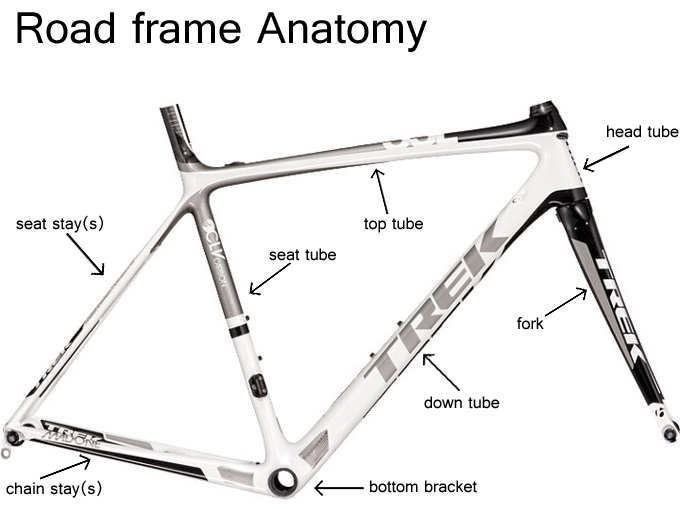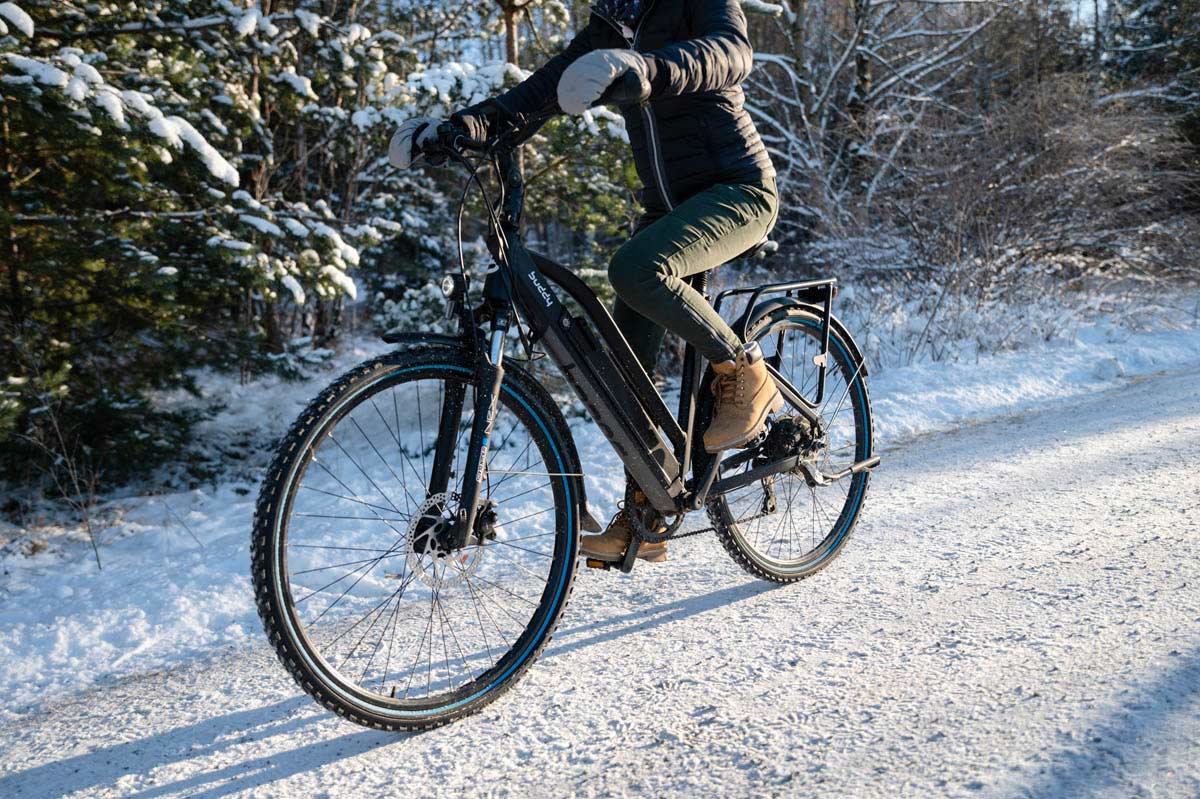We should choose the e-bike that is best harmonized with our riding habits and demands. Selecting the most suitable frame is centre stage.
Ebike frame elements and their function
Frame material
Let’s resume the main characteristics of each frame material with this table, knowing that the most widely adopted is aluminium, titanium and steel being rare.
| Bike price | Weight | Stiffness | Comfort | Everyday use | |
| Carbon: | high | very low | very high | high | very low |
| Aluminum: | medium | low | high | low | high |
| Steel: | very low | very high | low | very high | very high |
| Titanium: | very high | low | medium | very high | high |
Frame geometry
When buying an ebike, choosing the right frame geometry plays an important role in optimising performance on every ride, influencing comfort and handling. Frame geometry is all the more important for ebikes, since they are heavier and allow higher speeds and steeper climbs than regular bicycles.
Frame parts:
- Head tube angle
- Stack
- Reach
- Front Center
- Wheelbase
- Seat tube length
- Seat tube angle
- Bottom bracket height
Head tube angle
The narrower the angle the head tube forms with the terrain, the more stable the e-bike will feel, especially in descents and when cornering. On the minus side, it can feel soft and floppy when turning, and harder to keep straight on steep climbs. On the other hand, a wider (steeper) head tube angle offers a more direct steering and enables easier shifting of position when climbing, but is not very suitable for descending. That’s why e-mountain bikes have slightly narrower (slacker) head tube angles than road ebikes. If you buy an adjustable stem, reckon its effects on the head tube angle when you heighten it. The heavy down tube batteries of most e-bikes add stability and better day handling even with narrower head tube angles. A slack, narrow head tube angle also enhances the shock absorbing power of the front suspension, because it offers a narrower angle of attack. For any ebike with a battery weighing more than 2 kg on the frame, shock absorbers thoroughly improve riding comfort and the front wheel duration.

KTM Macina Prowler Exonic – 2024 with a slack head tube angle.
Stack height
Stack height is the vertical distance from the bottom bracket to the top of the head tube. More height is better for steep ascending, a lower stack gives more agile distribution of weight in climbs and steering. Again, the increased weight of motor and battery plays a relevant role in the ebike balance.
Reach
Reach is the horizontal distance from the center of the bottom bracket to the center of the top of the head tube. A longer reach gives more stability when climbing and descending, a shorter one is more agile. Tall riders will feel uncomfortable if the reach is too short. Heightening an adjustable stem will shorten the reach, since it will bend toward the saddle. It’s normally better to buy an ebike with higher handlebar, if desired, rather than lifting up an adjustable stem.
Front centre
The front centre indicates the distance between the centre of the bottom bracket and the centre of the front hub. A longer front centre gives more stability over bumps and on steep climbs, and is therefore typical of e-mountain bikes. It is also determined by head tube angle and reach.
Chainstay length
Chainstay length is the distance between the centre of the bottom bracket and the rear axle. When it’s shorter, the e-bike is more agile, but loses stability and makes it weight distribution less easy, although the lower center of gravity of ebikes renders chainstay length less relevant. Just compare the chain stay length of the two ebikes below.
- Scott Sub Sport Eride 20 – longer chainstay
- Scott Silence Eride 20 Speed 2021 – shorter chainstay
Front center
The front centre is the distance between the centre of the bottom bracket and the centre of the front hub. Also depends onthe head angle and reach. A longer front centre improves balance of the E bike, especially on steep climbs, and allows a more comfortable and easier handling of big bumps.
Wheelbase
The wheelbase is the distance between front and rear axle. Intuitively, the longer, the more stable the ebike, the shorter, the more agile.
Seat tube length
Is the distance from the centre of the bottom bracket to the top of the seat tube. It determinates how long but also how low your seat post, hence how low your saddle can be set. Should you mount a new suspension seat post, reckon that the suspension will not allow you to lower the saddle all the way down.
Seat tube angle
the seat tube angle, when it’s narrow, offers a larger cockpit, but it makes it harder to weight the front of your eBike and gives the unpleasant sensation of peddling too far in front of your hips.
Bottom bracket height
It is the height between your bottom bracket and the ground. The lower it is, the easier you will hurt the ground with your pedals, both when returning and on rocky paths. On the other hand, a lower bottom bracket height lowers your center of gravity, making your e-bike more stable. Nevertheless, ebikes are heavier and the central position of motors and batteries of their majority lower their gravity center, allowing a higher bottom bracket, thus avoiding those nasty pedal shocks on the ground.
Why is frame geometry so important for ebikes?
What many people still pay attention to when buying a two-wheeler when it comes to non-motorized bicycles is often neglected when it comes to ebikes – namely the focus on the frame geometry.
The frame geometry is based on the relationship between the handlebars, saddle and seat height. Depending on the length of the frame tubes and the resulting angles of the bicycle frame in combination with the handlebar settings and saddle position as well as the cyclist’s body proportions, it determinates the seating position that the cyclist adopts on the bicycle, or e-bike.
The better the ebike frame and settings are matched to the cyclist’s anatomy, the more comfortable the riding position is and , the more comfortable the ride will be.
A good coordination ratio, which is primarily oriented towards the rider, reduces symptoms of fatigue, sore muscles and injuries, reduces the strain on the neck and back muscles and also supports the optimal posture of the spine. In addition, choosing a suitable frame configuration and the appropriate adjustment of the handlebars and saddle makes pedaling much easier and increases performance. The physical strength can be transferred to the bike much more efficiently, meaning that one’s own fitness can be used better on long tours or strenuous stages. In general, an advantageously chosen frame geometry relieves the strain on the entire body on all journeys. The palms of the hands are put under less strain, the neck muscles are put under far less strain and the back experiences less strain with every kilometer ridden if the best possible sitting position can be selected thanks to the optimally selected geometry of the bicycle frame.
You can find tips on choosing your ebike here.
Pictures Trek (top) and Scott






in short, anything that makes a traditional bike more efficient or comfortable, does the same for an e-bike and viceversa.
Hi Mark,
That’s a good synthesis, thanks, and one should also take into account the extra weight of motor and battery.
Cheers, Luca